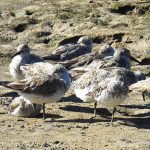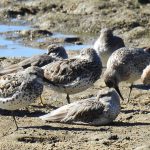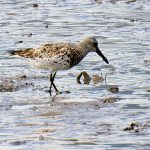GREAT KNOT
The Great Knot is a remarkable bird that showcases the resilience and complexity of nature’s migratory patterns. This medium-sized shorebird, with its mottled grey and rufous plumage, is not just a sight to behold but also an intriguing subject for those interested in avian life.
The Great Knot is a true globetrotter.
During the breeding season, which occurs in the short Arctic summer, these birds are found in the tundra of north-eastern Siberia. They prefer areas with sparse vegetation, close to water bodies, where the landscape is dotted with moss and lichen, providing a somewhat austere yet vital environment for nesting.
As the cold grips the Arctic, the Great Knot embarks on an awe-inspiring migration to warmer climates. They fly thousands of kilometers to the coastal mudflats of Australia, Southeast Asia, and East Asia for the winter. Australia’s shores, particularly places like Roebuck Bay in Western Australia and Eighty Mile Beach, become crucial refuges for these birds during this time. Some of these birds fly over 10,000 kilometers in one stretch, showcasing extraordinary endurance.
The Great Knot has a diet that primarily includes molluscs, crustaceans, worms, and occasionally, small fish. Their feeding technique is as fascinating as it is effective. Using their long, slightly upturned bills, they probe deep into the sand and mud, feeling for prey. This tactile feeding method allows them to capture food that is otherwise hidden from sight.
When it comes to breeding, the Great Knot displays a preference for simplicity. The nest is typically a shallow scrape on the ground, lined with leaves and lichen, camouflaged against the sparse tundra landscape. The female usually lays four eggs, which both parents help incubate. This cooperative parenting extends to protecting the chicks once they hatch, safeguarding them from predators and harsh weather until they are ready to fend for themselves. During the breeding season, their plumage undergoes a dramatic transformation from the usual grey to a vibrant breeding attire of rufous and black, a spectacle that highlights the dynamic nature of their lifecycle.
Great Knots can live up to 20 years, although many challenges reduce this expectancy. They are currently classified as vulnerable due to habitat loss, climate change, and human disturbances, particularly in their critical stopover and wintering areas. Conservation efforts are crucial to ensure that the wetlands and mudflats they depend on are preserved and that the ecosystems supporting their food sources remain intact.
The story of the Great Knot is a testament to the interconnectedness of global ecosystems and the remarkable adaptability of wildlife. It underscores the importance of international cooperation in conservation efforts and the need to maintain the natural habitats that these impressive travelers rely on. Their journey is not just a migration; it’s a poignant reminder of nature’s cycles and the global efforts needed to protect them.














